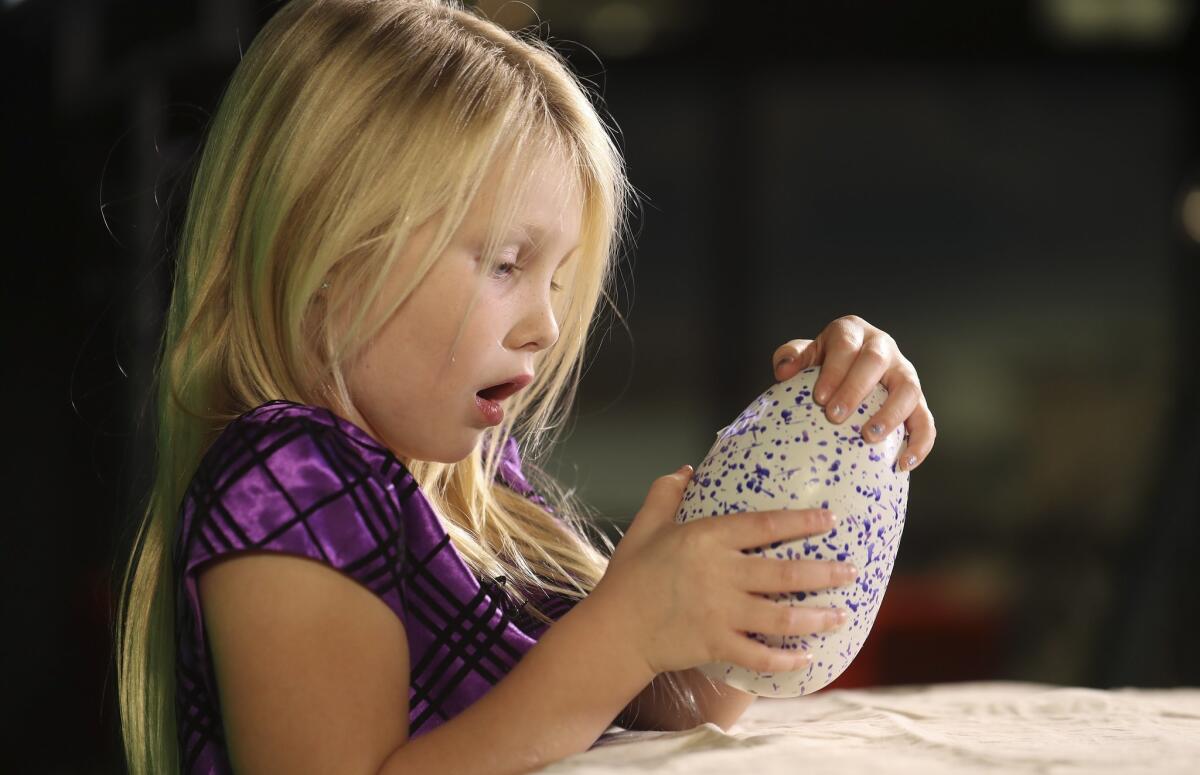Why it’s so hard to get your hands on the Christmas toy your kid really wants

Analysts: Some toy makers purposely hold back supply in an effort to drum up attention and incite a potential sales boost once more are released post-holidays.
- Share via
Every holiday season, there’s a must-have toy — a Hatchimal or Tickle Me Elmo that kids covet and frantic parents will do anything to find. Its scarcity drives many to stand in line for hours or pony up hundreds of dollars to scalpers, all the while asking: Why can’t toy companies just make more?
It’s not for lack of trying.
A breakout toy can be crucial to the $25-billion toy industry, with some companies pulling in 40% or more of their annual sales during the last two months of the year. But guessing the next hit is notoriously difficult.
Nervous about overproducing toys that wind up being flops, toy makers often release new products in limited supply. But because of the complexity of the global supply chain, ramping up production isn’t always easy.
The result: a holiday hype cycle in which demand creates buzz that fuels even more demand.
Toy companies and retailers often find themselves sprinting after a runaway winner, hurriedly ramping up production and even bringing on additional factories in the weeks before Christmas. Interest in hot toys usually lasts for 12 to 18 months, meaning companies must act quickly.
“Toys is absolutely a fashion business,” said Richard Barry, global chief merchandising officer at Toys R Us. “It is very, very high fashion in the sense that things come and they go.”
Among this year’s blockbusters are Hatchimals — furry animals that peck themselves out of an egg. After they hatch, they interact with humans, learn to walk, talk and even play games.

Toys R Us spotted the appetite for Hatchimals when they launched in early October, placing additional orders with Spin Master, the Toronto company behind the toys, Barry said. Even with that quick reaction, he said, expanding production of these kinds of electronic toys is tricky.
At Spin Master, the company went into “high gear” upon seeing a huge initial response, said spokeswoman Tara Tucker. The factory in China that produces Hatchimals began cranking up production right after the debut.
“We knew we needed to act on it,” Tucker said. “We did everything from trains and air freight as well as increased production immediately.”
Many retailers, including Toys R Us, have gotten additional shipments, but stock has quickly sold out. On EBay, Hatchimals sell for as high as $1,200 (they typically retail for $60 to $80).
“There is only so much we can do,” Tucker said. “However, by calling it so early that very first week it was on shelves, we have been able to produce much more had we delayed the decision.”
Nintendo, which also has a hit with the retro NES Classic Edition game console, said it, too, has been increasing production after a surprisingly big response. The research firm NPD Group recently said Nintendo sold nearly 200,000 units in its first month, outpacing sales of its modern Wii U console.
“It was unclear what its potential in the marketplace could be,” Doug Bowser, senior vice president of sales and marketing for Nintendo in America, wrote in an email.
Augustine Gaona, 37, was one shopper who immediately understood the gadget’s appeal. He was one of about 80 customers who braved the cold Tuesday morning outside the Best Buy in Atwater Village, awaiting an NES Classic Edition shipment.
For the downtown Los Angeles resident, the draw was largely nostalgia — he missed out on the original NES system in 1985 because his parents couldn’t afford one. Now, Gaona wanted to make sure his 9-year-old son could enjoy what he had pined for as a kid.

“I really missed out on it in my childhood, and I know it would appeal to him,” said Gaona, wrapped in a hot pink blanket borrowed from a woman a few places up in line. “I’m here to connect with him.”
Manufacturers and retailers alike benefit from shoppers’ frenzied search for the toy equivalent of a four-leaf clover. In the run-up before Christmas, many chains only sell what little stock they have in bricks-and-mortar locations, using it as a lure to draw people into stores. Some toy makers purposely hold back supply in an effort to drum up attention and incite a potential sales boost once more are released post-holidays, analysts said.
“There is artificial scarcity,” said Craig Johnson, president of research firm Customer Growth Partners. That’s when “people create a shortage and make it seem like it’s hot. Meanwhile, they have a gazillion of them sitting in a warehouse.”
But there’s actual scarcity too. It can afflict companies with complex products, analysts said, or firms caught totally by surprise when an unlikely plaything achieves must-have status.
“Sometimes, there is no rhyme or reason to it,” Johnson said. “You go back long enough, the hot toy was a pet rock.”
Imperial Toy, based in North Hills, has had to scramble to catch up with two hit toys in recent years.
In 2010, it was Googly Bands, colorful rubber bands in the shape of animals. Two years ago, a microphone that played songs from the Disney blockbuster film “Frozen” was a surprise bestseller.
Production was hastily bumped up at factories in China for both items, said co-chief executives Peter Tiger and Art Hirsch. The company air freighted Googly Bands, and it switched production of all its singing microphones to “Frozen” songs.
Despite decades in the business, both Tiger and Hirsch said it’s impossible to predict what the next coveted toy will be.
“If you could bottle that, you’d be a genius,” Hirsch said.
Jumping quickly onto a hot item can make or break a year, especially for smaller toy manufacturers, said Ron Friedman, a retail expert at Marcum. A toy maker can sell 30 million units or more of just one hit if it catches the wave at the very start, he said.
“It is short-lived and it lasts for a season,” he said. “When it’s over, it’s over. It just dies.”
That doesn’t stop toy companies from trying to maintain the fervor into the new year. Many continue to introduce new toys under the same brand that enjoyed explosive sales during the holidays. Some will even introduce television shows inspired by a toy line, analysts said.
Tucker, of Spin Master, wouldn’t go into specifics about future plans for Hatchimals. But she said the company learned its lessons from Bakugan, a line of collectible toys and playing cards that debuted in 2007. Just when Spin Master thought interest was waning in Bakugan, an unexpected sales surge caught the company by surprise — with no new toys in the pipeline to prolong that interest, she said.
“The company learned a lot from that experience,” Tucker said. “You have to keep the innovation going, as well as diversity,”
But toy makers that wish to keep the hype going must contend with another bump in the supply chain: Chinese New Year.
China’s biggest holiday, which occurs in late January into February, means millions of factory workers go on break to be with their families. In their absence, factories shut down completely.
Toy companies that import from China must get their orders in quickly or risk receiving no products for months, said Hirsch of Imperial Toy. By then, kids may have moved onto the next shiny thing.
“If you order late, they are made in late February and only come to port in March,” he said. “By the time it gets on shelves, it’s April.”
Follow Shan on Twitter @ByShanLi
ALSO
Storm soaks Southern California; LAX jammed
Uber pulls its self-driving cars off the streets of San Francisco
How 4 drug companies rapidly raised prices on life-saving drugs
More to Read
Inside the business of entertainment
The Wide Shot brings you news, analysis and insights on everything from streaming wars to production — and what it all means for the future.
You may occasionally receive promotional content from the Los Angeles Times.











